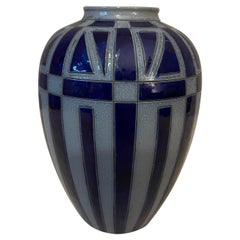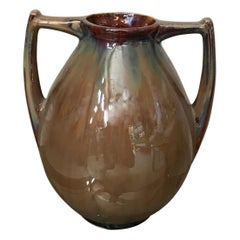Sandstone Ceramics
1
to
1
1
1
1
1
832
4,613
2,625
898
332
1
1
1
Material: Sandstone
Incense burner by Katsuyoshi Kotoge in Kyoto, Japan
Located in Paris, FR
A two-tone spherical incense burner. The 9-hole lid in grey-white glazed stoneware with gilded handle. The main body in glazed, veined earthenware. Made by master Katsuyoshi Kotoge (...
Category
2010s Japanese Sandstone Ceramics
Materials
Sandstone
Related Items
Japanese Contemporary Ko-Imari Gold Blue Porcelain Koro Incense Burner
Located in Takarazuka, JP
Stunning contemporary Japanese Ko-Imari style porcelain koro or incense burner or jewelry box, hand painted on a beautifully shaped round body in cobalt blue, red and green and gener...
Category
21st Century and Contemporary Japanese Meiji Sandstone Ceramics
Materials
Gold
Old Japanese Porcelain Lidded Incense Burner in the Original Box
Located in Norton, MA
Old Japanese porcelain lidded incense burner in the original box
The lid with the lion, two pierced handles on each side, and four feet at the four corners to stand.
This is an old...
Category
Mid-20th Century Sandstone Ceramics
Materials
Porcelain
Rare Meissen Marcolini Porcelain Chinoiserie Incense Burner Vase and Cover
Located in New York, NY
A rare Meissen Marcolini Porcelain Chinoiserie incense burner vase and cover, made for the Chinese market, circa 1800, blue cross swords and star mark, Pressnummer 58
A Museum Quality Piece.
Painted in the sought after famille rose palette with sprigs of indianische Blumen and enriched in gilding, the simulated pierced body supported by four feet painted with stylized dragons, the pierced cover with a Buddhist lion finial.
10" high x 6" wide x 6" deep
The shape of this piece, which appears to be unrecorded in the literature, is inspired by similar Chinese porcelain censers from the Qing Dynasty, Kangxi Period (1654-1722). An example in the Palace Museum, Beijing, is illustrated by Li Yi-hua in Qing Porcelain of Kangxi, Yongzheng and Qianlong Periods from the Palace Museum Collection, Hong Kong, 1989, pl. 65. Another in the British Museum, London (museum no. PDF, A.812) is catalogued as a perfume-holder.
These porcelain examples are in turn inspired by ancient Chinese bronzes from both the Shang (1600-1046 BC) and the Zhou (1046-246 BCE) dynasties, an example of which was sold anonymously by Christie's New York, 22 March 2019, lot 1601. This chain of inspiration tracking backwards from the 19th century to antiquity provides a clear example of how ceramics, and indeed other mediums, are able to influence and motivate the works of later generations.
For a Meissen porcelain snuff...
Category
Late 18th Century German Chinoiserie Antique Sandstone Ceramics
Materials
Porcelain
Small Japanese Satsuma Incense Burner, Koro, Meiji Period, Late 19th Century
Located in Austin, TX
A fine Japanese Satsuma stoneware incense burner, koro, Meiji Period, late 19th century, Japan.
The koro of square shape with curved sides, supported by four shaped and splayed le...
Category
1890s Antique Sandstone Ceramics
Materials
Enamel
H 5.25 in W 4 in D 3.75 in
Chinese Qing Dynasty Green Glazed Incense Burner, Late 19th Century
Located in Austin, TX
A charming Chinese green glazed pottery censer or incense burner, Qing Dynasty, late 19th century. Now suitable for use as a jardiniere or vase.
The incense burner in glazed a deep green, in imitation of bronze models, and set on four tapered legs attached to a rectangular stand...
Category
Late 19th Century Chinese Qing Antique Sandstone Ceramics
Materials
Pottery
Antique Japanese Satsuma Mini Koro Incense Burner Japan Meiji Period
Located in Amsterdam, Noord Holland
Description:
Fabulous Japanese Satsuma koros. Small red marks on both lid and koro, 19th century.
Condition:
Overall condition perfect. Size: 85 x 80mm H x D
Period:
Meiji P...
Category
19th Century Japanese Meiji Antique Sandstone Ceramics
Materials
Earthenware
Japanese Satsuma Incense Burner, Koro, Meiji Period, Late 19th Century, Japan
Located in Austin, TX
A fine and elegant Japanese Satsuma tripod incense burner, koro, with pierced metal lid, signed Eizan (?) Meiji Period, late 19th century, Japan.
The koro, or censer, features a stoneware body of slightly compressed globular form, supported on three short and squat legs. The wide mouth with a recessed metal rim, and topped by an openwork metal lid topped with overlapping chrysanthemum blossoms of silver repousse.
The body of the koro finely painted with fan shaped cartouches. The fans in the foreground with sprays of blossoming chrysanthemum. The fans in the background with intricate geometric brocade designs.
The shoulder of the incense burner decorated with cartouches formed as stylized chrysanthemum petals, and intricately decorated with geometric and floral brocade designs.
The painting finely done in raised gilt and polychrome enamels, including the highly desirable gosu blue...
Category
Late 19th Century Japanese Meiji Antique Sandstone Ceramics
Materials
Silver, Metal
Japanese Glazed Ceramic and Silver Koro Incense Burner Makuzu Kozan
By Makuzu Kozan
Located in Atlanta, GA
A tri-pod ceramic incense burner (koro) by Japanese Imperial potter Makuzu Kozan (1842-1916) circa late Meiji to the start of Taisho period (1890-1910s). A fine example of the artist's work belonging to the late part of his underglaze paint phase (started around 1887 until his death), the surface of the koro was painted in beautiful shades of blue to depict a continuous landscape not unlike a traditional ink and watercolor hand scroll. The rise and fall mountains recede and fade into the horizon and are dotted with groves of pines. The sky is painted with a beautiful subtle shade of pink, suggesting a time of sunrise or sunset. The koro is fitted with an ensuite reticulated sterling silver hoya (incense cover), pierced with swirling cloud and marked with "pure silver' in Kanji. The base is signed in underglaze blue "Makuzu Kozan Sei" within a double ring. The piece is beautifully potted in form and the decoration was done with expertise using the novel technique developed by Kozan called Fuki-e (the blow painting), in order to achieve the striking landscape known as "Mountain and Water" with sense of dimensions and gradient, the poetic effects normally conveyed only by sumi ink staining on paper. The piece comes with an unsigned tomobako (wood storage box) of a recent age.
Also known as Miyagawa Kozan (1842–1916), Makuzu Kozan was one of the most established and collected ceramist from Meiji Period. Born as Miyagawa Toranosuke, Kozan established his pottery studio in Yokohama around 1870s and later became one of the appointed artists to the Japanese Imperial household. His work was exhibited in many international fairs that the Meiji government participated at the turn of the century and won many grand prizes. Being one of the most creative ceramists, Kozan started experimenting with new chemical colors from the West in the format of his porcelain glaze around 1880s. New colors allowed him to create underglaze designs that appeared bright, smooth and glossy. He even invented his own receipt of cobalt blue to achieve a much brighter yet softer shade, as evident on this vase. To create landscape that is realistic and dimensional, more common in the western paintings, he was inspired by the native Japanese ink painting technique developed around 1900 by Yokoyama...
Category
Early 1900s Japanese Japonisme Antique Sandstone Ceramics
Materials
Silver
Japanese antique pottery small incense burner/bonsai pot/1868-1920
Located in Sammu-shi, Chiba
This is believed to be a small incense burner made in Japan during the Meiji and early Taisho periods (1868-1920).
The design is very simple but b...
Category
Late 19th Century Japanese Meiji Antique Sandstone Ceramics
Materials
Pottery
Antique Japanese Porcelain Brazier 'Incense Burner', Signed
Located in Norton, MA
A very unusual Antique Japanese Porcelain Brazier (Incense Burner) with green checker pattern, Signed on the bottom.
Category
Early 20th Century Japanese Sandstone Ceramics
Materials
Porcelain
Ceramic Ritual Incense Burner with Bagua Pattern Korean Joseon Dynasty
Located in Atlanta, GA
An antique Korean ritual incense burner circa 19th century, late Joseon dynasty. It was made in Bunwon Kiln in Gwangju, Gyeonggi Do, near Seoul. The ceramic container has a thickly b...
Category
19th Century Korean Archaistic Antique Sandstone Ceramics
Materials
Ceramic
White Porcelain Incense Burner / Korean Antique / Joseon Dynasty/1392 - 1897 CE
Located in Kyoto-shi, Kyoto
This incense burner presents the characteristics of a typical Yi Dynasty Joseon Dynasty incense burner with a body that rises smoothly from the base, openworked ears and a semi-circu...
Category
17th Century Korean Antique Sandstone Ceramics
Materials
Ceramic
Free Shipping
H 9.45 in W 7.09 in D 7.09 in
Previously Available Items
20th Century French Blue and Grey Sandstone Art Deco Vase, 1930s
Located in LEGNY, FR
Very nice small blue and grey Art Deco sandstone vase from the north of France (Alscace).
Signed under the base.
Nice quality and condition.
Category
1930s French Art Deco Vintage Sandstone Ceramics
Materials
Sandstone
20th Century French Sandstone Signed Vase, 1940s
Located in LEGNY, FR
20th century French sandstone signed Alpho and numbered vase from the 1940s.
Beautiful brown and blue colors. Handles on each side.
Signed Alpho at the back and numbered 1850.
G...
Category
1940s French Vintage Sandstone Ceramics
Materials
Sandstone




